Effect of Nanoparticle Concentration on the Performance of Ni-Co-β-SiC Composite Coatings Electrodeposited on the Surface of Spindle Hook Teeth
Abstract
:1. Introduction
2. Materials and Methods
2.1. Materials
2.2. Experimental
2.3. Instruments
3. Results and Discussion
3.1. Analysis of the Micromorphology of the Composite Coating
3.1.1. Analysis of the Surface Micromorphology of the Composite Coating
3.1.2. Analysis of the Cross-Sectional Micromorphology of the Composite Coating
3.2. Effect of β-SiC Concentrations on Coating Composition
EDS and Mass Fraction Analysis of the Composite Coating
3.3. Effect of β-SiC Concentrations on Coating Hardness and Wear Resistance
3.3.1. Analysis of the Microhardness of the Composite Coating
3.3.2. Friction Coefficient Analysis of the Composite Coating
3.3.3. Wear Resistance Analysis of the Composite Coating
4. Conclusions
Author Contributions
Funding
Institutional Review Board Statement
Informed Consent Statement
Data Availability Statement
Conflicts of Interest
References
- Fan, J.R. Present situation research and development trend of cotton harvest machine. Mech. Res. Appl. 2011, 24, 1–4. (In Chinese) [Google Scholar]
- Sun, K. Wear mechanism analysis of cotton picker spindle. Agric. Dev. Equip. 2021, 11, 46–47. (In Chinese) [Google Scholar]
- Lin, L.B.; Dai, P.Q.; Lin, L.F.; Liao, Y.X. Corrosion characteristics of nanocrystalline Co-Ni-Fe deposits in 3.5% NaCl solution. Rare Metal Mater. Eng. 2012, 41, 851–856. (In Chinese) [Google Scholar]
- Zhang, H.Z.; Li, J.; Ou, X.M.; Chen, H. Electroless Deposition and Corrosion Resistance of Ni-Co-Cu-P Amorphous Coatings. Rare Metal Mater. Eng. 2016, 45, 2965–2969. (In Chinese) [Google Scholar]
- Hu, J.; Wang, B.; Hu, J.T.; Xu, Y.C.; Pu, D.L.; Zhou, C. Effect of nSiO2 on Corrosion Resistance of Ni-W-P Coating in High Temperature and High Pressure Environment. Surf. Technol. 2018, 47, 68–74. (In Chinese) [Google Scholar]
- Wang, J.Y.; Zhang, X.; Zhang, X.G.; Liu, J.T.; Wang, X.C. Performance Characterization of Ni-P-xZrO2 Nano-Composite Coating by Electrodeposition on Cylinder Liner Surface of Robot Arm. Mater. Prot. 2021, 54, 97–101. (In Chinese) [Google Scholar]
- Zhang, K.; Li, Y.F.; Zhao, H.Y.; Han, H.J.; Yang, Z.J. Preparation and Properties of Sol-Enhanced Ni-P-Al2O3 Nanocomposite Coatings. Mater. Prot. 2020, 53, 77–83. (In Chinese) [Google Scholar]
- Safavi, M.S.; Rasooli, A. Ni-P-TiO2 nanocomposite coatings with uniformly dispersed Ni3Ti intermetallics: Effects of TiO2 nanoparticles concentration. Surf. Eng. 2019, 35, 1070–1080. [Google Scholar] [CrossRef]
- Shen, M.Q.; Fu, X.Q.; Kang, M.; Zhang, Y. Process of Jet-Electrodeposited Ni-P-ZrO2 Coating on Rotary Body Parts. Mater. Prot. 2019, 52, 96–101. (In Chinese) [Google Scholar]
- Jiang, W.; Shen, L.D.; Xu, M.Y.; Wang, Z.W.; Tian, Z.J. Mechanical properties and corrosion resistance of Ni-Co-SiC composite coatings by magnetic field-induced jet electrodeposition. J. Alloys Compd. 2019, 791, 847–855. [Google Scholar] [CrossRef]
- Ahmadkhaniha, D.; Zanella, C. The Effects of Additives, Particles Load and Current Density on Codeposition of SiC Particles in NiP Nanocomposite Coatings. Coatings 2019, 9, 554. [Google Scholar] [CrossRef]
- Jiang, W.; Shen, L.D.; Wang, K.; Wang, Z.W.; Tian, Z.J. Wear resistance of Ni-Co/SiC composite coating by jet electrodeposition in the presence of magnetic field. Proc. Inst. Mech. Eng. Part B 2019, 243, 431–438. [Google Scholar] [CrossRef]
- Kazimierczak, H.; Szymkiewicz, K.; Bobrowski, P.; Swiatek, Z.; Rogal, L.; Gileadi, E.; Eliaz, N. The Effect of SiC Nanoparticle Size on the Electrodeposition of Zn–SiC Nanocomposite Coatings from Citrate Bath. J. Electrochem. Soc. 2018, 165, 774–782. [Google Scholar] [CrossRef]
- Yang, Z.G.; Fu, X.Y.; Yi, S.J.; Wang, S.; Li, Q.; Guo, S.J. Effects of different deposition methods on microstructure and friction properties of Ni-W/SiC composite coatings. J. Funct. Mater. 2022, 53, 6205–6211. (In Chinese) [Google Scholar]
- Su, P.; Liu, H.; Wang, X.H.; Long, W.; Jiang, Y.G.; Li, Z.S.; Wang, Q. Effect of heat treatment temperature on microstructure and properties of Ni-W-P/TiO2composite coating. Trans. Mater. Heat Treat. 2022, 43, 166–174. (In Chinese) [Google Scholar]
- Liu, Y.T. Research on the Process and Properties of Ni-Mn-SiC Composite Coatings by Jet-Electrodeposition; Master of Engineering; Nanjing Agricultural University: Nanjing, China, 2020. (In Chinese) [Google Scholar]
- Du, X.X. Research on the Process and Properties of Ni-P-β-SiC Composite Coating by Pulse jet Electrodeposition; Master of Engineering; Nanjing Agricultural University: Nanjing, China, 2017. (In Chinese) [Google Scholar]
- Li, J. Research on Wear Law and Wear Device of Spindle Hook Teeth Coating; Professional Master of Mechanical Engineering; Nanjing Agricultural University: Nanjing, China, 2022. (In Chinese) [Google Scholar]
- Guglielmi, N. Kinetics of the deposition of inert particles from electrolytic baths. J. Electrochem. Soc. 1972, 119, 1009–1012. [Google Scholar] [CrossRef]
- Shen, Z.Y. Study on Preparation of Ni-P-SiC Composite Coatings by Scanning Electrodeposition on 45 Steel Substrates with Sandblasting Pretreatment; Professional Master of Mechanical Engineering; Nanjing Agricultural University: Nanjing, China, 2021. (In Chinese) [Google Scholar]
- Garcia-Lecina, E.; Garcia-Urrutia, I.; Diez, J.A.; Salvo, M.; Smeacetto, F.; Gautier, G.; Seddon, R.; Martin, R. Electrochemical preparation and characterization of Ni/SiC compositionally graded multilayered coatings. Electrochim. Acta 2009, 54, 2556–2562. [Google Scholar] [CrossRef]
- Pavlatou, E.A.; Stroumbouli, M.; Gyftou, P.; Spyrellis, N. Hardening effect induced by incorporation of SiC particles in nickel electrodeposits. J. Appl. Electrochem. 2005, 36, 385–394. [Google Scholar] [CrossRef]
- Chavoshi, S.Z.; Branicio, P.S.; An, Q. Transition between Hall-Petch and inverse Hall-Petch behavior in nanocrystalline silicon carbide. Phys. Rev. Mater. 2021, 5, 073606. [Google Scholar] [CrossRef]
- Zhang, Z.; Chen, D.L. Contribution of Orowan strengthening effect in particulate-reinforced metal matrix nanocomposites. Mater. Sci. Eng. A 2008, 483, 148–152. [Google Scholar] [CrossRef]
- Zhang, Y.; Kang, M.; Fu, X.Q.; Li, H.Z.; Liu, Y.T. Surface structure and wear resistance of Ni-Co-P-BN (h)- Al2O3binary nano composite coatings. Mater. Sci. Technol. 2019, 27, 55–66. (In Chinese) [Google Scholar]
- Jin, P.; Sun, C.F.; Zhou, C.Y.; Shi, L.; Liu, C. Effect of SiC particle size on structures and properties of Ni–SiC nanocomposites deposited by magnetic pulse electrodeposition technology. Ceram. Int. 2019, 45, 20155–20164. [Google Scholar] [CrossRef]
- Gu, Y.Q.; Zhang, H.W.; Fu, X.Q.; Wang, L.; Wang, J.; Cai, Y.X.; Li, H.Y. Comparative Analysis of the Wear Performance of Spindle Hook Teeth During Fieldwork. J. Tribol. 2022, 144, 011706. [Google Scholar] [CrossRef]
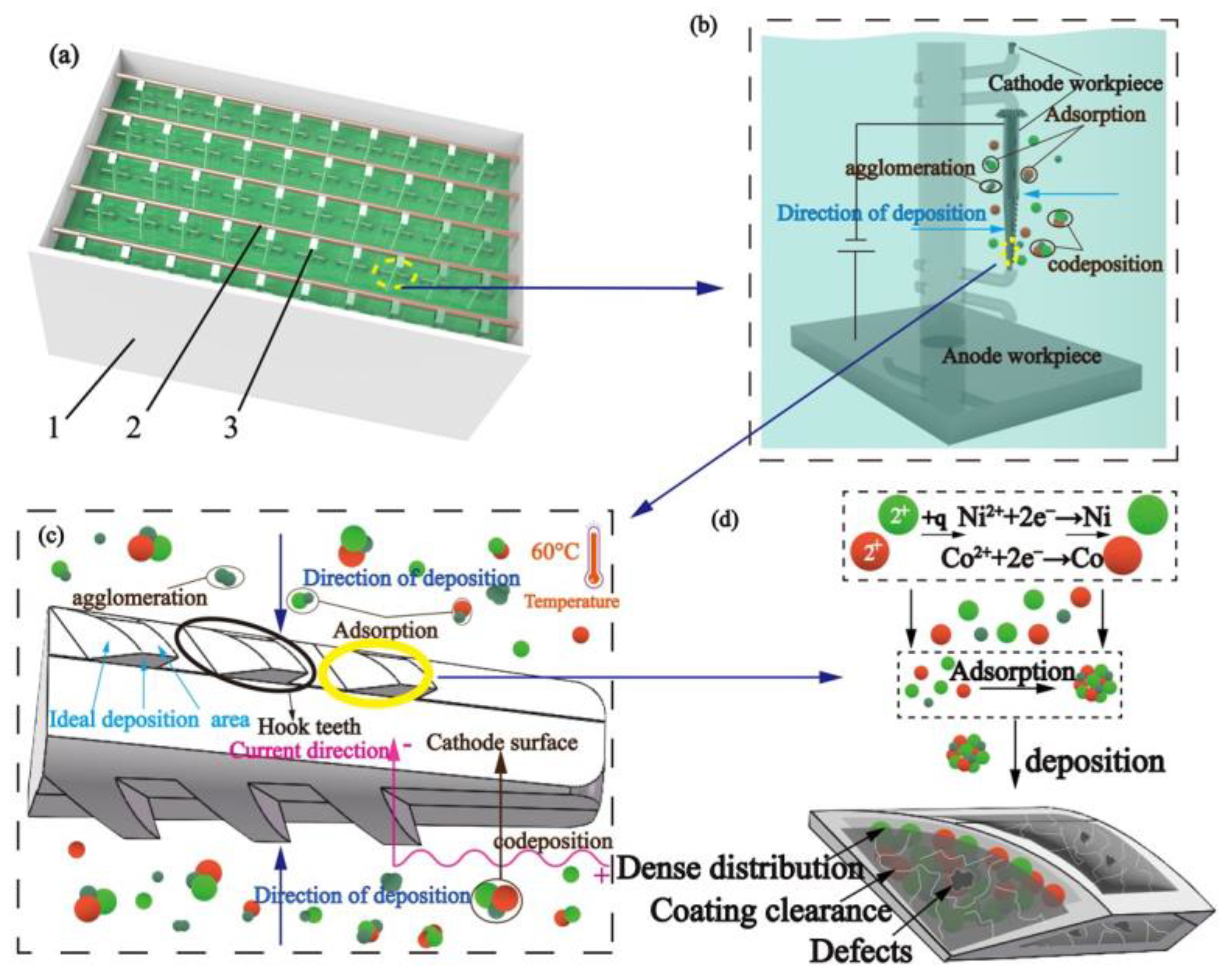

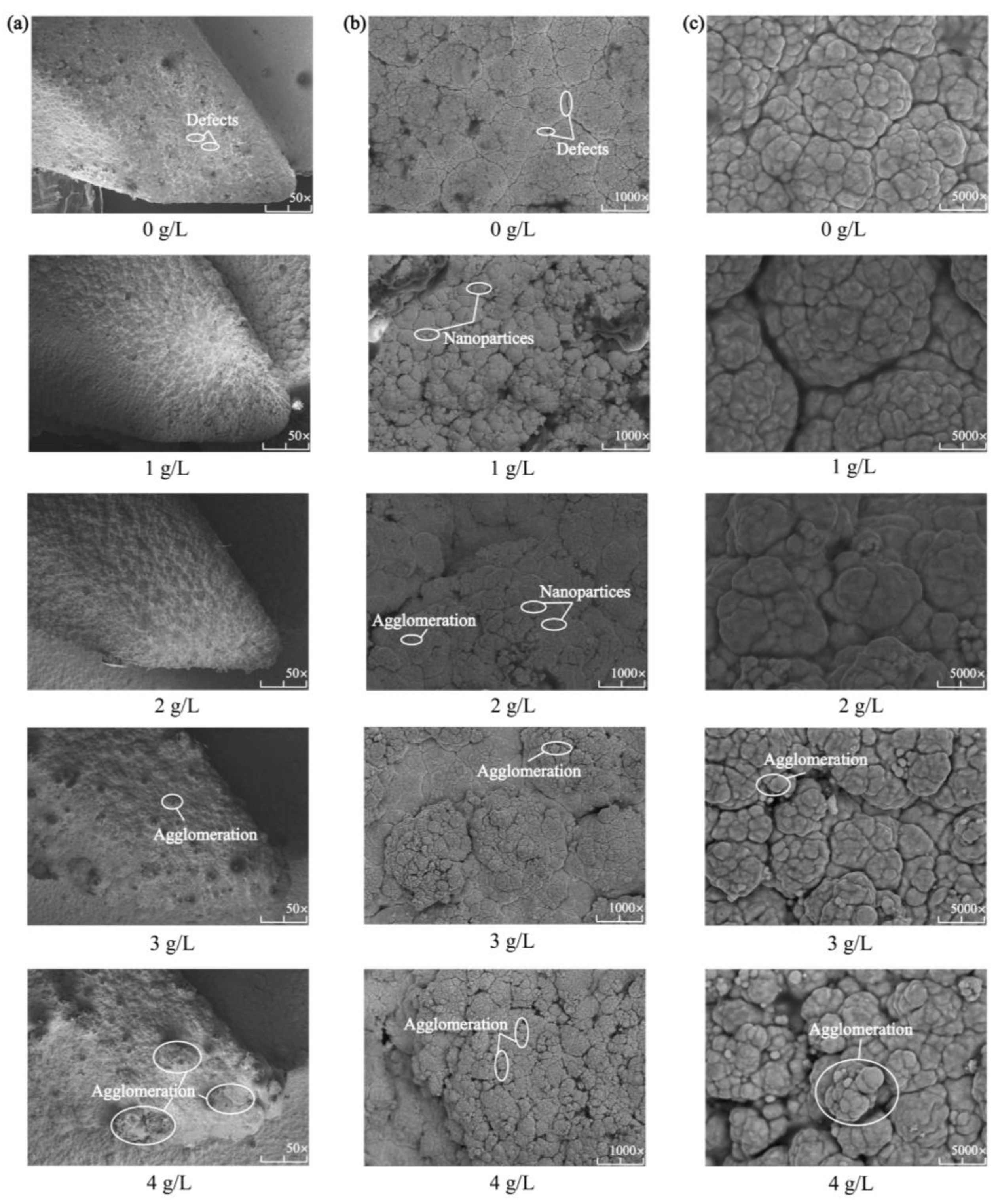
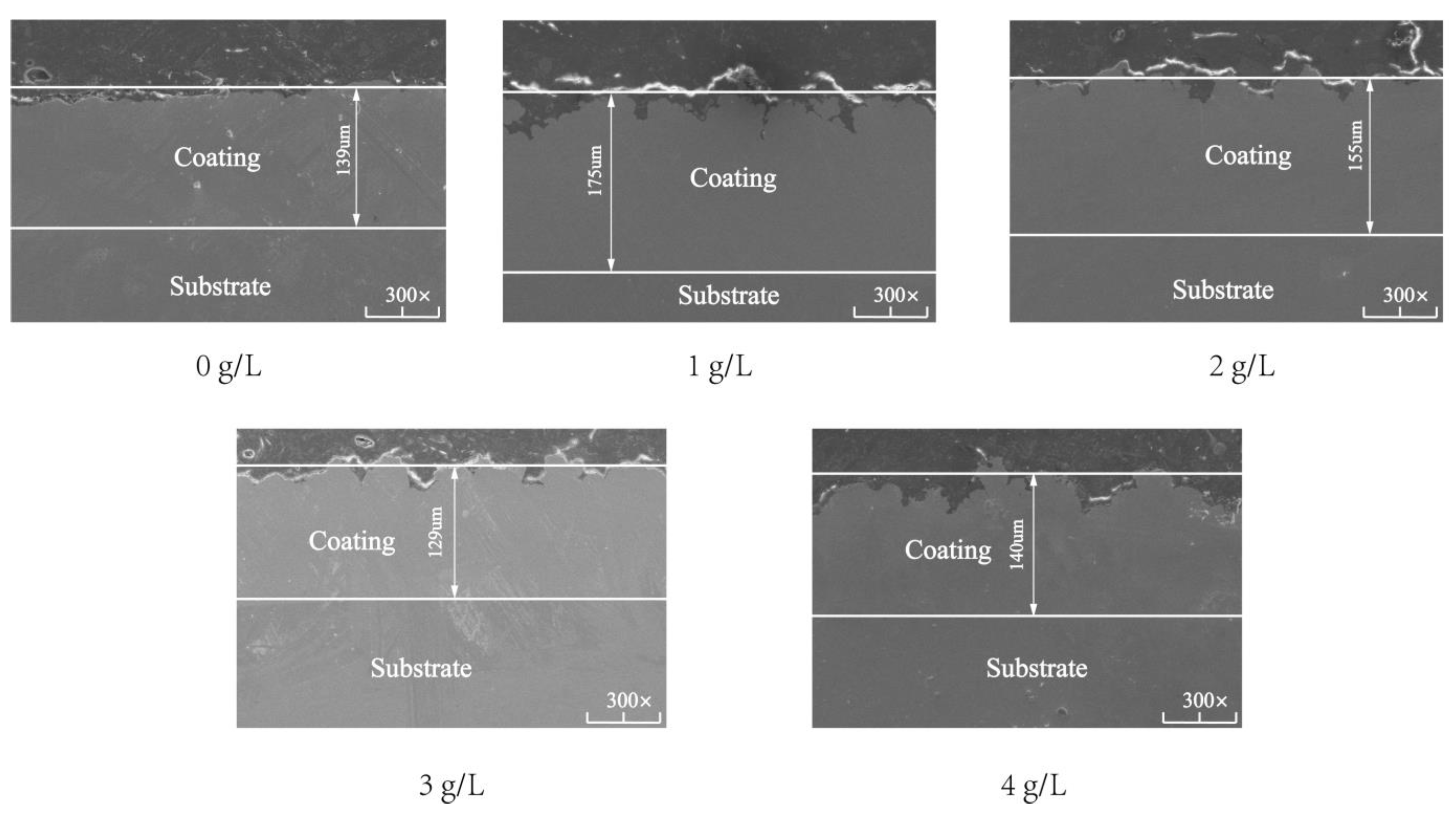

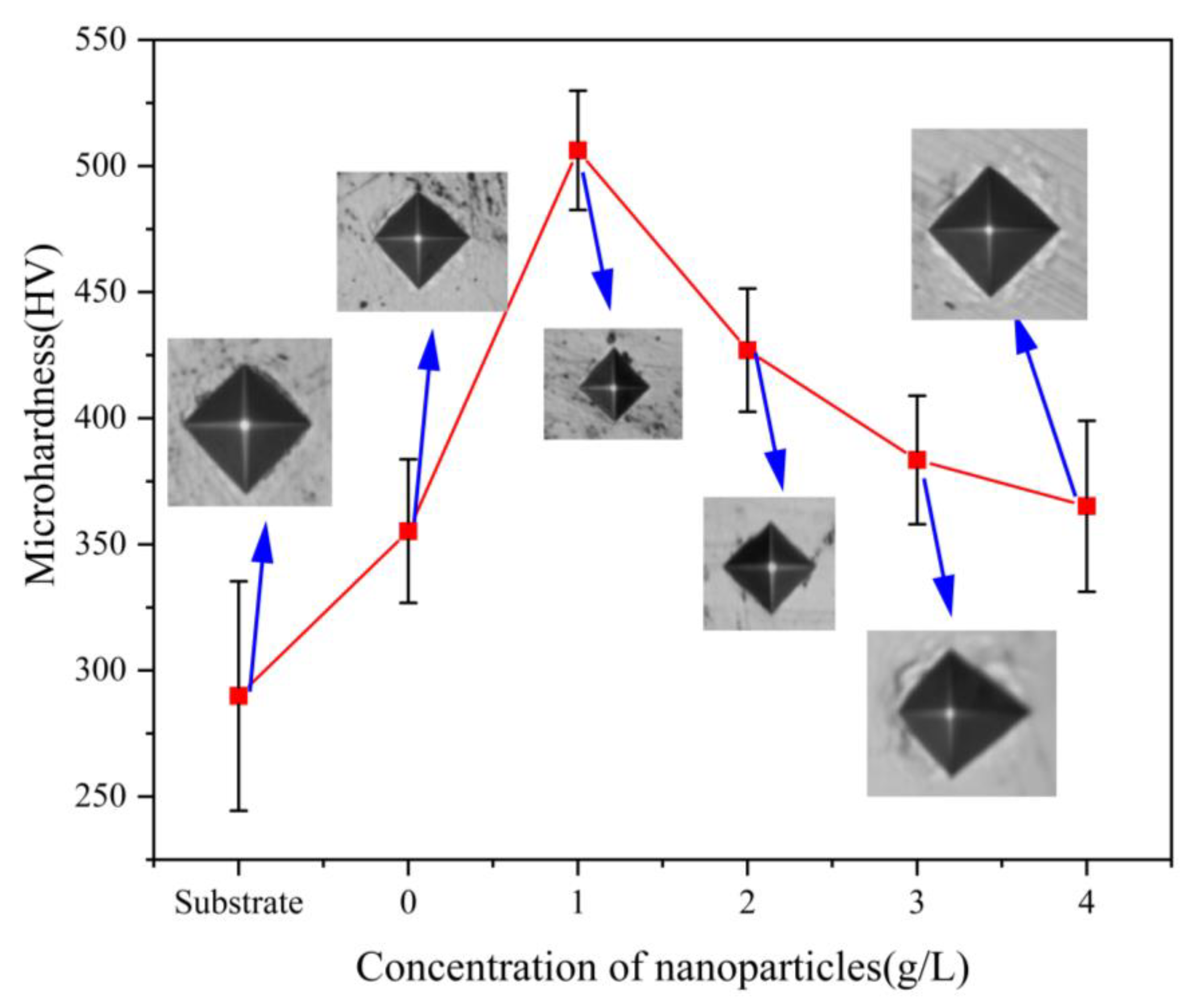


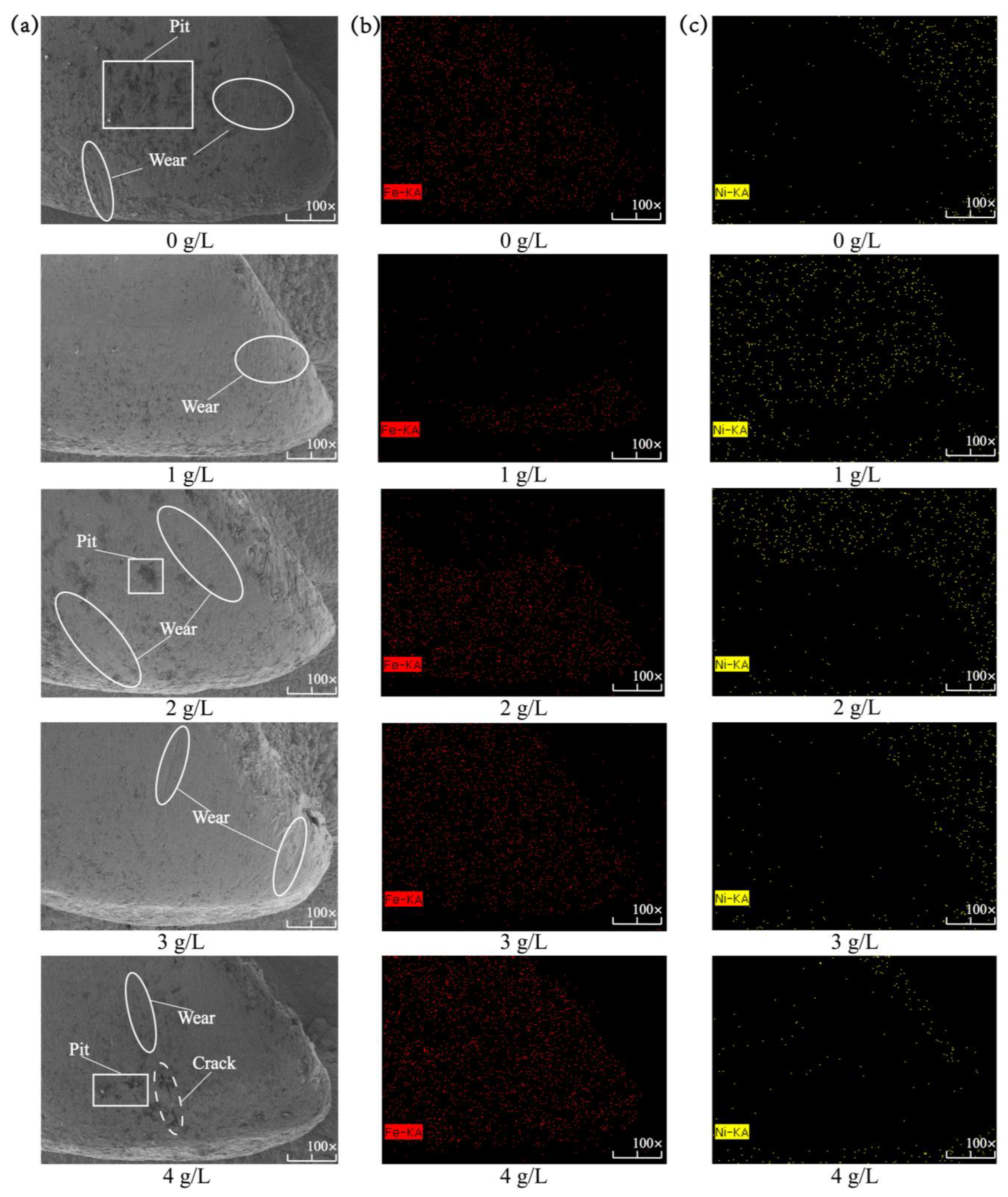
| Parameter Name | Value | Unit |
|---|---|---|
| Total length of spindles | 122 | mm |
| Diameter of spindles | 12.4 | mm |
| Cylindrical length | 50.2 | mm |
| Taper length | 62.7 | mm |
| Taper angle | 3.3 | ° |
| Helical Teeth Row number | 3 | Row |
| Composition | Content (g/L) | Effect |
|---|---|---|
| NiSO4∙6H2O | 200 | Provide Ni2+ |
| NiCl4∙6H2O | 50 | Reduce free cations |
| CoSO4∙7H2O | 5 | Provide Co2+ |
| H3BO3 | 30 | pH SRP |
| C12H25SO4Na | 0.05 | Surfactant |
| CH4N2S | 0.002 | Stabilizer |
| β-SiC nanoparticles (30 nm) | 0/1/2/3/4 | Secondary phase nanoparticles |
| β-SiC (g/L) | Ni (wt.%) | Co (wt.%) | Si (wt.%) | C (wt.%) |
|---|---|---|---|---|
| 0 | 44.78 | 13.57 | 0.32 | 4.63 |
| 1 | 67.03 | 9.60 | 0.90 | 4.18 |
| 2 | 43.10 | 13.48 | 0.49 | 3.87 |
| 3 | 37.14 | 15.11 | 0.76 | 3.51 |
| 4 | 58.94 | 9.82 | 0.56 | 5.32 |
| β-SiC (g/L) | Width (µm) | Height (µm) | Scratch Area (mm2) |
|---|---|---|---|
| 0 | 465.680 | 40.001 | 1.238 |
| 1 | 395.266 | 34.496 | 0.995 |
| 2 | 424.913 | 35.436 | 1.110 |
| 3 | 436.031 | 37.104 | 1.163 |
| 4 | 506.441 | 39.830 | 1.344 |
| β-SiC (g/L) | Ni (wt.%) | Fe (wt.%) | Co (wt.%) | Si (wt.%) |
|---|---|---|---|---|
| 0 | 28.51 | 41.59 | 3.69 | 1.27 |
| 1 | 50.62 | 7.72 | 3.96 | 2.71 |
| 2 | 47.87 | 24.41 | 4.18 | 1.50 |
| 3 | 17.09 | 56.50 | 2.42 | 2.71 |
| 4 | 6.14 | 63.04 | 2.64 | 1.37 |
Disclaimer/Publisher’s Note: The statements, opinions and data contained in all publications are solely those of the individual author(s) and contributor(s) and not of MDPI and/or the editor(s). MDPI and/or the editor(s) disclaim responsibility for any injury to people or property resulting from any ideas, methods, instructions or products referred to in the content. |
© 2023 by the authors. Licensee MDPI, Basel, Switzerland. This article is an open access article distributed under the terms and conditions of the Creative Commons Attribution (CC BY) license (https://creativecommons.org/licenses/by/4.0/).
Share and Cite
Ni, H.; Fu, H.; Wang, H.; Zhang, H.; Zhu, Y.; Fu, X. Effect of Nanoparticle Concentration on the Performance of Ni-Co-β-SiC Composite Coatings Electrodeposited on the Surface of Spindle Hook Teeth. Coatings 2023, 13, 422. https://doi.org/10.3390/coatings13020422
Ni H, Fu H, Wang H, Zhang H, Zhu Y, Fu X. Effect of Nanoparticle Concentration on the Performance of Ni-Co-β-SiC Composite Coatings Electrodeposited on the Surface of Spindle Hook Teeth. Coatings. 2023; 13(2):422. https://doi.org/10.3390/coatings13020422
Chicago/Turabian StyleNi, Haoyang, Haiwei Fu, Hongbiao Wang, Hongwen Zhang, Yifan Zhu, and Xiuqing Fu. 2023. "Effect of Nanoparticle Concentration on the Performance of Ni-Co-β-SiC Composite Coatings Electrodeposited on the Surface of Spindle Hook Teeth" Coatings 13, no. 2: 422. https://doi.org/10.3390/coatings13020422
APA StyleNi, H., Fu, H., Wang, H., Zhang, H., Zhu, Y., & Fu, X. (2023). Effect of Nanoparticle Concentration on the Performance of Ni-Co-β-SiC Composite Coatings Electrodeposited on the Surface of Spindle Hook Teeth. Coatings, 13(2), 422. https://doi.org/10.3390/coatings13020422







